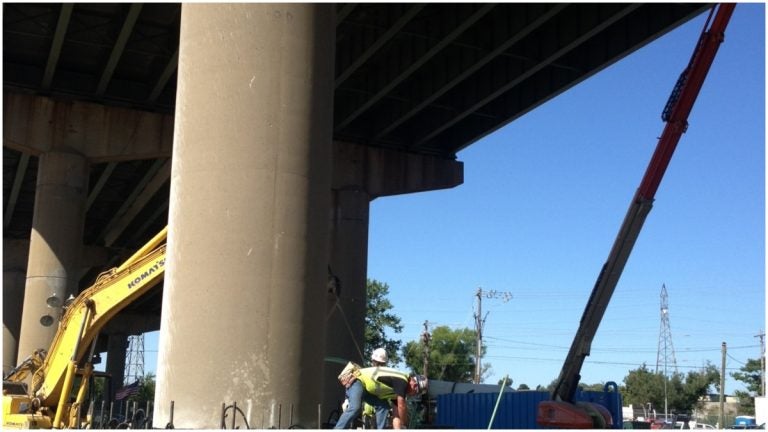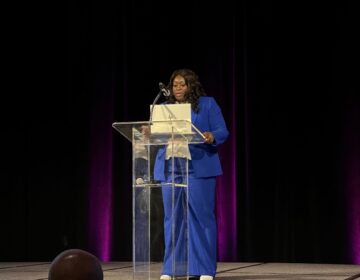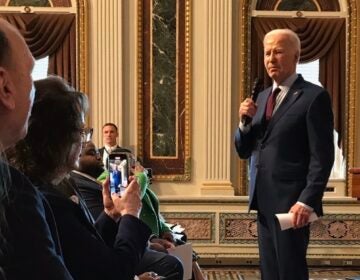The road to repair: insight into Delaware’s I-495 bridge closure

Construction crews work around the clock on I-495 bridge.(Nichelle Polston/WHYY)
In light of the surprise reopening of the southbound lanes of the I-495 bridge on Thursday, it’s important to consider the steps along the way and the impacts of the bridge’s closure.
Since June, construction crews have worked around the clock to fix the state’s longest bridge, which was closed in June after transportation officials discovered almost 400 feet in damage to the mile-long bridge’s foundation. The damage was attributed to piles of dirt that were unloaded next to several piers that support the roadway.
According to Barry Benton, the Delaware Department of Transportation’s assistant director of bridges, the columns tilted as a result of the soil that the bridge is built on.
“This material out here is very soft. For about the first hundred feet, it is more like a mucky type of material, and that’s what caused the problem,” Benton said.
Pier 14 was one of the damaged piers; even an untrained eye can clearly see a crack in the foundation. Above the bridge, the view was even more alarming: A huge gap is visible between the northbound and southbound bridge lanes.
“The barriers are supposed to be even with each other at this point, and at the maximum they are about 18 inches apart at the worst spot,” Benton said.
Engineers and contractors faced various challenges with the repair project, especially when it came to hauling equipment to repair the bridge.
“Normally when you build a bridge, you start from the foundation and then you build your substructure and superstructure, we’re asically having to hold the existing bridge while we construct the new piers,” said Javier Torrijos, assistant director of Construction. The closure has necessitated several detours through Wilmington.
Local impacts
Much of the detoured was rerouted through Wilmington Councilwoman Hanifa Shabazz’s district.
Although she’s pleased with the manner in which city and state officials have joined together to ease traffic congestion, Shabazz still had some concerns.
“We have 18-wheelers coming into our neighborhood, and there’s another thought about whether or not our streets have the capacity to maintain the extra weight and [the] vibrations and what it’s doing to some of the older housing structure’s foundations,” Shabazz said.
She also has concerns about the detour’s impacts on health and safety.
“We have a lot of asthma in the east side and south Wilmington area. They are asthma clusters, so [with] the added exhaust, we’re concerned about how that’s affecting the health of the neighborhood,” Shabazz said.
Since repairs began on the bridge, Downtown Visions, an organization that manages Wilmington’s downtown business district, came up with the idea to lessen traffic woes. A handful of local restaurants, including several along the detour routes, advertised an “I-495 lunch special” sticker in their windows, a $4.95 deal.
‘Good as new’
While the negative impacts are hopefully short-lived, project leaders said that the repairs are built to last.
Overall, four of the piers were damaged due to the dirt piles. DelDOT officials said that two piers will be replaced and two will be retained. In addition, crews will work to rebuild a stronger foundation. The new foundation will be much wider and will surround the existing pier base with four corners of extra concrete.
“There’s going to be an eight-foot thick concrete foundation that is going to transmit the load from the piers out to shafts, and the existing footing (foundation) won’t be counted on for anything,” Benton said.
While the bridge passed its last inspection in October 2012, officials explained that the he rebuilt foundations will prevent the piers from shifting in the future. They’re certain that commuters will have nothing to worry about once the bridge reopens.
“These piers will be as good as new, so they will be here for the duration and life of the bridge,” Torrijos said.
WHYY is your source for fact-based, in-depth journalism and information. As a nonprofit organization, we rely on financial support from readers like you. Please give today.




